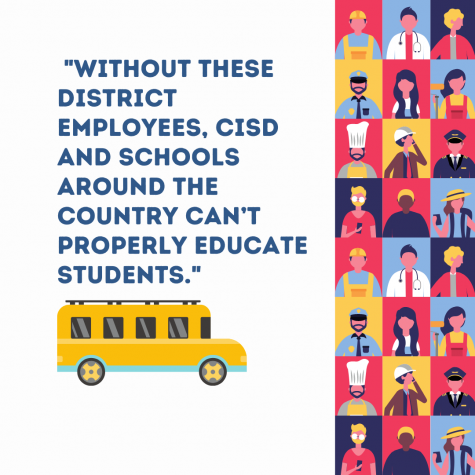Labor Shortage Felt at Carroll Schools
December 17, 2021
The labor shortage that plagues the country may have seemed to waver, but its reverberations can be felt in Carroll ISD. School personnel such as bus drivers, custodians and cafeteria workers are choosing to quit either because of their coworkers’ departures or other unfavorable conditions like insufficient pay or the burden of their former coworkers’ loads. Without these district employees, CISD and schools around the country can’t properly educate students.
As reported by NBC, the sectors most affected were “accommodation and food services, wholesale trade, and state and local government education.” Bus drivers, janitorial workers, and lunch employees all fit into one or more of these categories, illustrating the impact of the labor shortage on educational settings.
Many students at Carroll Senior High have been affected firsthand by the lack of bus drivers for shuttle buses. These shuttle buses transit students between the high school and senior high and are usually filled to a comfortable fullness, with a few open seats. Now, they are filled to the brim with students, sometimes to the point where there are three kids at a seat.
According to a CISD bus driver who would like to stay anonymous, around a quarter of CISD bus drivers left because of the labor shortage, and CISD can’t restore the previous numbers fast enough. School bus drivers require an inordinate amount of certifications which take longer to accrue than a typical driver’s license.

“To supplement the bus driver situation, the director has recruited coaches with the bus license to pick up driving shifts when they can,” Mr. Ryan Wilson, principal of Carroll Senior High School, said.
The sudden shock of the labor shortage has left a discrepancy between the efficiency of school transportation and the well-being of both students and school personnel.
Because of the labor shortage, CISD lunch workers have been maimed due to their lack of work support. The food service sector has been hit particularly hard because food preparation for large groups of people requires systematic efficiency. Missing cogs in that machine will lead to disarray, confusion, and overburdening.
According to Aracely Alvarez, a cafeteria worker at Carroll Senior High School, the number of lunch staff has decreased from 14 in 1996 to nine and now to a paltry three staff members as a result of the labor shortage.
With only three lunch ladies working to feed 1200 kids every day, Wilson said that the nutrition director has recruited volunteer parents to help in the kitchen. Currently, this is getting lunches out, but the remedial hiring process has been slow. Because many food service employees have reported feeling their pay doesn’t compensate for the services they provide, they are leaving in droves, making the remaining cafeteria corps members’ jobs more demanding.
Janitors, the unsung caretakers of educational settings, espouse similar experiences. Less personnel means more work to distribute between existing custodial staff, thereby increasing pressure to perform without the proper compensation to follow.
Carroll Senior High School janitor Rigoberto Gomezmontano attributes his increased workload to the recent labor shortage. According to Rigoberto, there were a total of 85 janitors in the district before the shortage, 14 of which have left. He, like many other school laborers, is still uncertain as to what other impacts the labor shortage will have or what remedies the school district will enforce.
Wilson said, “The custodial department is suffering most with fewer and fewer people to work for the comparable wage the district is willing to pay. We’ve also tried incentivizing applicants with signing bonuses which hasn’t brought the success we had hoped.”

